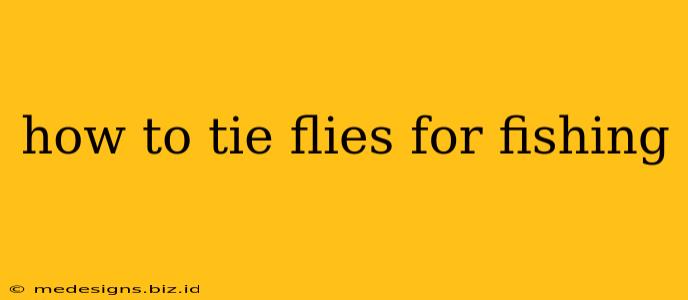So you want to learn how to tie flies for fishing? That's fantastic! Tying your own flies is a rewarding hobby that can save you money and allow you to create custom patterns perfectly suited to your local waters and target species. This comprehensive guide will walk you through the basics, equipping you with the knowledge and confidence to start crafting your own fishing lures.
Essential Tools and Materials for Fly Tying
Before you dive in, you'll need a few essential tools and materials. Don't feel pressured to buy everything at once – start with the basics and gradually expand your collection as you gain experience.
Essential Fly Tying Tools:
- Fly Tying Vise: This is arguably the most important tool. A good vise will securely hold your hook throughout the tying process. There are many types available, from simple rotary vises to more sophisticated models with features like bobbins and built-in lighting.
- Fly Tying Scissors: Sharp, small scissors are crucial for precise cutting of materials.
- Whip Finisher: This tool helps create neat, durable knots, especially for finishing your flies.
- Bobbin: A bobbin holds your tying thread and makes it easier to manage.
- Hackle Plier: Used to shape and secure hackle feathers.
Essential Fly Tying Materials:
- Hooks: A wide variety of hooks are available, each designed for different fly patterns and fish species.
- Tying Thread: This is used to secure all the materials together. Choose a strong, durable thread in a color that complements your fly pattern.
- Feathers: These provide the bulk and movement to your fly. Experiment with different types of feathers, like rooster hackle, pheasant tail, and goose biots.
- Floss and Dubbing: These are used to create the body of your fly, adding texture and bulk.
- Flash Material: Materials like tinsel, Mylar, and Krystal Flash add sparkle and attract fish.
Your First Fly: The Simple Adams Dry Fly
Let's start with a classic: the Adams dry fly. This pattern is relatively easy to tie and is effective for catching a wide range of trout species.
Materials Needed for the Adams Dry Fly:
- Hook: Size 14-18 dry fly hook
- Thread: 6/0 or 7/0 black or brown
- Tail: 1-2 strands of grizzly hackle fibers
- Body: Fine, light brown dubbing
- Wing: White CDC (Cul De Canard) feathers or similar material. If unavailable, use white calf hair.
- Hackle: Brown grizzly hackle
Step-by-Step Instructions:
- Secure the Hook: Mount the hook securely in your vise.
- Attach the Thread: Start by tying in your thread near the eye of the hook.
- Tie in the Tail: Tie in the grizzly fibers, creating a short tail.
- Create the Body: Apply the dubbing to the thread and create a smooth body.
- Tie in the Wing: Tie in the CDC feathers or calf hair, creating a wing.
- Tie in the Hackle: Tie in the brown grizzly hackle and wind it around the hook shank.
- Finish the Fly: Whip finish the thread and trim any excess materials.
Tips for Success
- Practice Makes Perfect: Don't be discouraged if your first few flies aren't perfect. Keep practicing, and you'll improve your technique over time.
- Watch Videos: YouTube is a great resource for learning fly-tying techniques. Watching videos can help you visualize the process and pick up helpful tips.
- Join a Club: Connecting with other fly tiers can provide valuable support and inspiration. Consider joining a local fly-tying club or attending workshops.
- Experiment: Don't be afraid to experiment with different materials and patterns. The best way to learn is by trying new things.
Beyond the Basics: Expanding Your Skills
Once you've mastered the basics, you can explore more advanced fly-tying techniques, such as:
- Nymphs: These are subsurface flies that imitate aquatic insects.
- Wet Flies: These are fished below the surface and often have a more buoyant body.
- Streamers: These are larger flies that imitate baitfish and other larger prey items.
- Saltwater Flies: These are designed for saltwater fishing and are typically larger and more durable.
Fly tying is a skill that takes time and patience to develop, but the rewards are well worth the effort. So grab your tools, gather your materials, and start creating your own fishing masterpieces! Happy tying!
